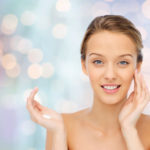Free Consultation in Central London
No obligation appointment with a surgeon
SKIN 101
An Ideal Skincare Regimen
Free Consultation in Central London
No obligation appointment
Click below to contact us

Introduction
There are so many skincare brands and lines being marketed, each claiming to be better than one another, it is increasingly difficult to filter out what are the most useful elements in a practical daily routine. This is a multi-part piece about a standard skincare regimen that will suit almost everyone and then, we will talk about more specific items that help a particular skin goal.
Here are the shortcuts to the Evidence Based Skincare Regimen Series!
- Cleansing
- Moisturising
- Sun Protection
- Anti-Aging Additions
We aim to present a basic skincare regimen for almost any skin type and we will go through effective anti-aging products as add-ons to your regime. We aim to provide only products that have been backed by good evidence. You won’t find anecdotal, untested products!
2. Moisturising
This is a crucial step in any regimen regardless of whether you have dry skin or not. Too little water content in the skin means dry, flaky, rough, irritated skin. Moisturisers are essential in those with skin conditions such as eczema where the epidermal barrier is interrupted is there is increased water loss from the skin. Moisturised, supple skin is characterised by water trapped between the deeper (dermal) layer and the outer-most layer of the epidermis (stratum corneum). When there is break in this layer, moisturisers become even more important by promoting water retention under the stratum corneum layer with ‘humectants’. They also minimise water evaporation and increase integrity of the skin barrier via ‘occlusives’. Emollients complements occlusives and smooth out the skin surface.
What Do Moisturisers Contain?
Humectants are materials that have high water-absorption qualities and increase the moisture holding capabilities of the stratum corneum. In high humidity environments, they can also attract moisture from the air and those using high humectant creams in such climates will notice that once they go outside, their skin will very quickly start to feel less dry and even a little sticky. The most common humectant is glycerol (or glycerin) and will be present in many of your creams. Others will use propylene glycol, sorbitol or urea.
Occlusives are oily substances aimed at reducing evaporatio of water from the skin. It produces a hydrophobic layer over the skin and maintains an adequate barrier. You will see these substances in your creams, such as fatty acids (lanolin, linoleic acid), oils, waxes (paraffins, petrolatum, dimethicones, beeswax). Some people are allergic to lanolin and this should be looked out for in their creams. Petrolatum is the least allergenic of the occlusives.
Emollients help to smooth and moisturise skin by filling in gaps between surface skin cells. They improve the appearance of skin, increasing smoothness and softness. They also even skin tone by increasing light refraction. Many emollients are also humectants and occlusives.
Types Of Moisturisers & Their Use
Individuals with dry skin should moisturise at least twice a day, morning and evening. In drier or colder environments, it may be beneficial to moisturise during the middle of the day. Most moisturisers are creams or lotions. Creams are water in oil emulsions. Lotions are oil in water emulsions and are lighter in texture. Generally, lotions work well during the day and creams at night. In dry conditions, creams in the morning may be necessary.
Those with oily skin may feel like they do not need moisturisation at all. However, in dry conditions and in winter, often even oily skin may feel quite dry. Lotions will be better here and will feel less heavy on the skin. Many oily skins will have mixed skin types where the T-zone will be more oily and the cheeks can be relatively dry. Additionally, acne treatments that are often used in oily skin individuals are very drying products.
The ideal moisturiser has similar qualities to the ideal cleanser: gentle, non-irritant, hypo-allergenic, fragrance-free and non-comedogenic. Most moisturisers have additional properties these days, such as sun protection, anti-oxidants, vitamins or retinoids, depending on what special qualities the manufacturers claim the moisturiser has.
Next Steps...
How to incorporate your cleansing into your routine should be very individualised. It depends on your skin type, needs and other components of your overall regimen. At Lumaesthetic, we can discuss all of these points at your free consultation. There is no single treatment type that can improve everyone's skin health and facial aesthetics in the same way. It will be a personalised combination of different treatments and skin advice.
Read on for the next steps in our Evidence Based Skincare Regimen Series!
- Cleansing
- Moisturising
- Sun Protection
- Anti-Aging Additions
Popular Topics
How to optimise your skin consistently using robust medical evidence, rooted in science.
Avoid fads and be wise to extravagant marketing.
The Needle & Knife
With so many options for facial rejuvenation, how do surgeons choose the right procedure for our patients?
What Ages Skin?
We look at the main influences that have been shown to significantly affect the way and rate our skin ages.
1. Cleansing
Understand your cleansers and what works well for different skin types
2. Moisturising
Understand your moisturisers and what is most appropriate for your skin
3. Sun Protection
Understand why sun protection is one of the most important aspects of skincare
4. Anti-Aging
Scientifically proven anti-aging products







